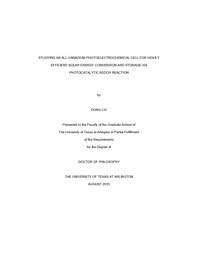| dc.description.abstract | This study aims at developing a promising alternative approach to utilize solar energy continuously with high efficiency by employing photocatalytic vanadium redox reactions to overcome major drawbacks associated with conventional photoelectrochemical water splitting. The preliminary study was implemented on TiO2 and WO3/TiO2 by linear sweep voltammetry (LSV), cyclic voltammetry (CV) and zero-resistance ammetry (ZRA) in a photoelectrochemical cell (PEC). The results show much enhanced photoelectrochemical response with the assistance of vanadium(IV, VO2+) redox species. Such photoresponse improvement is attributed to the hole scavenging effect by fast vanadium redox reaction to depress charge recombination at semiconductor/liquid interface in both TiO2 and WO3/TiO2 cases. Facilitated electron transfer from WO3 to TiO2 further contributes to the photoresponse of WO3/TiO2 hybrid electrode due to their band structures interplay. During the study, a unique photocharging/discharging process was discovered and modeled on WO3-based hybrid electrodes due to the formation/decomposition of hydrogen tungsten bronze (HxWO3) from WO3 under AM 1.5 illumination in highly acidic environment. Comparison of electrochemical impedance spectroscopy (EIS) results on TiO2 and WO3/TiO2 electrodes indicates that vanadium redox species, due to their fast electrochemical kinetics, not only enhance the photocurrents under illumination, but also help release reversely the stored electrons under dark through decomposition reaction of HxWO3.To further improve photocatalytic property of the PEC, the conventional H2SO4 was replaced with a novel supporting electrolyte, methanesulfonic acid (MSA) as a simple but feasible optimization measure. CV, zero-resistance ammetry (ZRA) and conductivity measurements demonstrate its excellent chemical stability, high conductivity and superior photoelectrochemical performance over H2SO4, especially when vanadium redox species were involved in the electrolyte. The root cause of such ability of MSA relies on its prolonged electron lifetime and being capable of dramatically diminishing charge transfer resistance and interfacial capacitance at photoelectrode/electrolyte interface under AM1.5 illumination, according to EIS Nyquist plot and Bode plot results. To quantify the efficiency of proposed all-vanadium PEC, the Faradaic efficiency and Incident photon-to-electron conversion efficiency of the cell were measured. While the Faradaic efficiency of the cell reaches to 84.8% after a 60-h cell operation, the IPCE of the cell was improved on V-MSA by a factor of 18.6, 9.7 and 2.5 compared to pure H2SO4, V-H2SO4 and pure MSA respectively. Such remarkable IPCE enhancement of the cell is believed due to synergy between fast vanadium redox kinetics and prolonged electron life time of MSA. | en_US |

